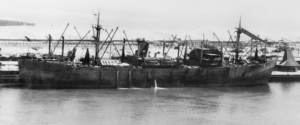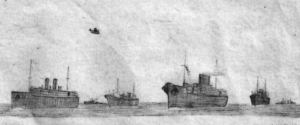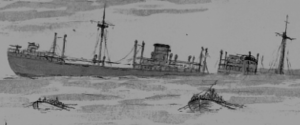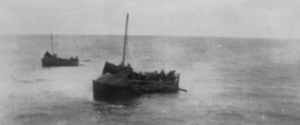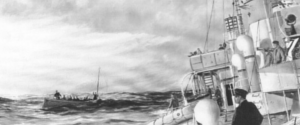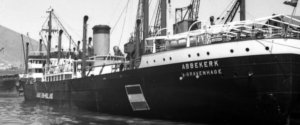300 miles south of Java: Abbekerk under attack!


Troops on the boat deck, midship Abbekerk. Picture by Captain James E. Crane, flight Surgeon FEAF (Thanks to Jim Crane)
28 February 1942. With over 1700 people on board Abbekerk sails due south, alone on an empty sea. With calm weather and not even half loaded her two large diesel engines power her to a speed of over 19 knots. She does follow an irregular zigzag pattern to prevent a successful attack by a submarine. Away from the chaos and uncertainty of Tjilatjap and with freedom just days ahead now, the men are fairly cheerful, thinking they left the worst behind.
This mood changed abruptly around noon when the ship’s alarm sounded. In a tense silence, the major mounted the bridge and announced that all three of the ships they were to have to joined in convoy had been sunk by Jap bombers, and that a pack of enemy submarines was reported lying in wait somewhere ahead. Every man was to be a lookout!
It was if a bleak wind blew through the ship. Games ceased. Men crowded the rails, straining their eyes for a periscope or the first horizon speck of an approaching plane. Even the heedless understood the uncertain balance on which their lives depended.
‘They fought with what they had’ by Walter D. Edmonds
It was clear that if they can make it undetected till nightfall, the next morning they would be over 600 miles away from Tjilatjap and most likely out of the most immediate danger zone. At the end of the day that hope was shattered.
On the afternoon of February 28, at 1700 hours, an airplane appeared in the sky. It kept a good distance from us and circled for an hour. It was a Nip off an aircraft carrier no doubt. (..) We sat there on the deck and watched him as chickens might watch a hawk. Soon the son of a bitch came in and made a pass at us and dropped something off our stern. To this day I don’t know whether it was a bomb or a belly tank. All we could see was a big splash. We had been ordered to take cover when he came in toward us, so he would not be able to detect the number of troops on board, and of course to save ourselves from possible injury in the event of strafing. Those of us who had rifles and pistols took a shot at him, but this was a useless gesture because of the speed with which he went by us. He continued to circle us while the anti-submarine gun on the stern of our ship was firing four-inch ball ammunition at him. Each time he tried to come in and make a pass at us the old Dutch captain would flip the ship around so as to give him the smallest target and to give us the best shot at him. What few machine guns we had mounted on the boat were not effective mainly because of the range and the inexperience of our gun crews.
The old Dutch captain stood up on the bridge of his ship with a Tommy gun, giving us directions. Then when the Jap made a pass at us the Captain would fire at him too. Some goon shot down our own radio antenna on the boat deck and a few others threw some slugs through our funnel. Finally he flew away and disappeared.
Flight surgeon Captain James E. Crane, Far East Air ForceWhen the attacking aircraft came within range, first the four-incher fired. As the plane came closer, the 50s opened up. Then the 30s cut loose. A hail of tracer bullets reached out to our tormentor. At the same time, the ABBEKERK still at full speed made every possible evasive move.
Corporal Bill Heath, HQ Far East Air ForceWith so many soldiers on board I had no action station. I took my camera when the plane approached but could take no snaps as I was told to take cover. The US small arms fire and our Oerlikon guns drove him off.
Bernard Finn, 17 y/o messboy on Abbekerk.The aircraft turned and disappeared, not because of our guns but because the pilot had seen enough…What to do now? From the bridge we were asked to get a little more speed from the engines, which we did. At sundown the Captain ordered a substantial change in direction
Adriaan Kik, ass. engineer on Abbekerk
The plane was a Kate (Nakajima B5N) single engined bomber/torpedo plane on patrol from one of the six carriers of the Kido Butai close by. On board Abbekerk at that time all they knew was that is was a carrier plane and Abbekerks radio operator heard the pilot on the radio. Obviously broadcasting Abbekerks position to every Japanese unit in the area. It was only a matter of time now for more planes or ships to appear. The mood on board the overcrowded freighter was one of fear and powerless desperation.
Ships leaving Tjilatjap on February 28:
- Seawitch
- Benakat
- Van Goens
- Van Spilbergen
Losses February 28 (merchant ships only): Ban Ho Guan (Dutch): The cargo ship was torpedoed and sunk in the Java Sea off Bali, Dutch East Indies by submarine I-4. City of Manchester (British): The cargo ship was torpedoed and sunk in the Indian Ocean off Tjilatjap, Java, at by the submarine I-53 with the loss of three of the 137 people aboard. Six survivors were taken as prisoners of war. Other survivors were rescued by the minesweepers USS Lark and USS Whippoorwill. Prominent (Norway): The cargo ship was shelled and sunk 230 nautical miles (430 km) south of Tjilatlap, Dutch East Indies by Imperial Japanese Navy warships with the loss of 24 lives. Survivors were rescued by Tomohon and Zaandam. Tomohon (Dutch): The coaster was shelled and sunk off Tjilatjap, Dutch East Indies by Arashi and Nowaki (both Imperial Japanese Navy). All crew were rescued. War Sirdar (British): The Standard British WWI type tanker was torpedoed and damaged, or ran aground on a reef, in the Sunda Strait and was beached on Agenielien Island, Dutch East Indies on March 1. She was declared a total loss. She was refloated, and repaired between March and June, 1942 and put in Imperial Japanese Army service as Honan Maru . Source: - https://en.wikipedia.org/wiki/List_of_shipwrecks_in_February_1942 - "De Nederlandse Koopvaardij in de Tweede Wereldoorlog" by L.L. von Münching

